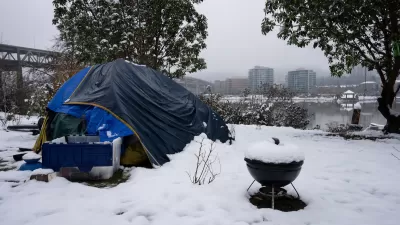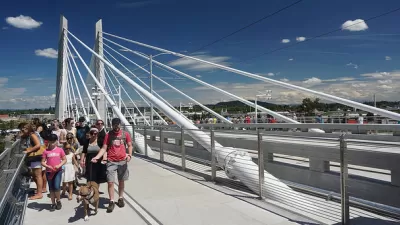Multnomah County is planning to spend $825 million to replace the Burnside Bridge, which engineers say is unlikely to withstand the force of a large eathquake.
Multnomah County, Oregon is planning and designing a new "earthquake ready" bridge that will span the Willamette River between the east and west of Portland.
Here's how an article by Andrew Theen summarizes the new Burnside Bridge:
County officials released conceptual designs late Monday for the proposed $825 million Burnside Bridge replacement. Whatever is built, it won’t be a flat structure like the existing bridge, so officials are interested in hearing what people think of the potential options. The replacement bridge will include a support structure above the bridge – like a tower – to make it more seismically sound and allow for fewer support columns in unstable soil.
According to Theen, all of the remaining design concepts for the bridge "resemble an amalgam of some of the city’s other iconic river crossings."
In a separate article, Jonathan Maus offers an initial look at the bike infrastructure planned for the new bridge, offering this summary of what people on bikes should expect of the new bridge:
Currently the bridge offers only minimal physical separation from other users via small plastic wands. The new bridge would have a much more substantial buffer. And as it stands today, the bridge has no visual obstructions while the new bridge would block views of downtown and the eastside.
"Timing-wise, this project is still in its environmental review phase and the County plans to release a draft Environmental Impact Statement for public review early next year. If all goes according to plan construction would begin in 2024," adds Maus.
According to Theen, the county is expected to settle on a chosen design next year.
FULL STORY: New Burnside Bridge could look like a combination of nearby Willamette River bridges

Maui's Vacation Rental Debate Turns Ugly
Verbal attacks, misinformation campaigns and fistfights plague a high-stakes debate to convert thousands of vacation rentals into long-term housing.

Planetizen Federal Action Tracker
A weekly monitor of how Trump’s orders and actions are impacting planners and planning in America.

San Francisco Suspends Traffic Calming Amidst Record Deaths
Citing “a challenging fiscal landscape,” the city will cease the program on the heels of 42 traffic deaths, including 24 pedestrians.

Defunct Pittsburgh Power Plant to Become Residential Tower
A decommissioned steam heat plant will be redeveloped into almost 100 affordable housing units.

Trump Prompts Restructuring of Transportation Research Board in “Unprecedented Overreach”
The TRB has eliminated more than half of its committees including those focused on climate, equity, and cities.

Amtrak Rolls Out New Orleans to Alabama “Mardi Gras” Train
The new service will operate morning and evening departures between Mobile and New Orleans.
Urban Design for Planners 1: Software Tools
This six-course series explores essential urban design concepts using open source software and equips planners with the tools they need to participate fully in the urban design process.
Planning for Universal Design
Learn the tools for implementing Universal Design in planning regulations.
Heyer Gruel & Associates PA
JM Goldson LLC
Custer County Colorado
City of Camden Redevelopment Agency
City of Astoria
Transportation Research & Education Center (TREC) at Portland State University
Jefferson Parish Government
Camden Redevelopment Agency
City of Claremont





























